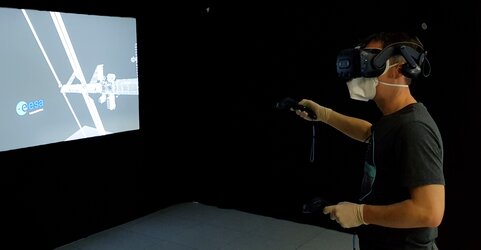Accept all cookies Accept only essential cookies See our Cookie Notice

About ESA
The European Space Agency (ESA) is Europe’s gateway to space. Its mission is to shape the development of Europe’s space capability and ensure that investment in space continues to deliver benefits to the citizens of Europe and the world.
Highlights
ESA - United space in Europe
This is ESA ESA facts Member States & Cooperating States Funding Director General Top management For Member State Delegations European vision European Space Policy ESA & EU Space Councils Responsibility & Sustainability Annual Report Calendar of meetings Corporate newsEstablishments & sites
ESA Headquarters ESA ESTEC ESA ESOC ESA ESRIN ESA EAC ESA ESAC Europe's Spaceport ESA ESEC ESA ECSAT Brussels Office Washington OfficeWorking with ESA
Business with ESA ESA Commercialisation Gateway Law at ESA Careers Cyber resilience at ESA IT at ESA Newsroom Partnerships Merchandising Licence Education Open Space Innovation Platform Integrity and Reporting Administrative Tribunal Health and SafetyMore about ESA
History ESA Historical Archives Exhibitions Publications Art & Culture ESA Merchandise Kids Diversity ESA Brand CentreLatest
Space in Member States
Find out more about space activities in our 23 Member States, and understand how ESA works together with their national agencies, institutions and organisations.
Science & Exploration
Exploring our Solar System and unlocking the secrets of the Universe
Go to topicAstronauts
Missions
Juice Euclid Webb Solar Orbiter BepiColombo Gaia ExoMars Cheops Exoplanet missions More missionsActivities
International Space Station Orion service module Gateway Concordia Caves & Pangaea BenefitsLatest
Space Safety
Protecting life and infrastructure on Earth and in orbit
Go to topicAsteroids
Asteroids and Planetary Defence Asteroid danger explained Flyeye telescope: asteroid detection Hera mission: asteroid deflection Near-Earth Object Coordination CentreSpace junk
About space debris Space debris by the numbers Space Environment Report In space refuelling, refurbishing and removingSafety from space
Clean Space ecodesign Zero Debris Technologies Space for Earth Supporting Sustainable DevelopmentLatest
Applications
Using space to benefit citizens and meet future challenges on Earth
Go to topicObserving the Earth
Observing the Earth Future EO Copernicus Meteorology Space for our climate Satellite missionsCommercialisation
ESA Commercialisation Gateway Open Space Innovation Platform Business Incubation ESA Space SolutionsLatest
Enabling & Support
Making space accessible and developing the technologies for the future
Go to topicBuilding missions
Space Engineering and Technology Test centre Laboratories Concurrent Design Facility Preparing for the future Shaping the Future Discovery and Preparation Advanced Concepts TeamSpace transportation
Space Transportation Ariane Vega Space Rider Future space transportation Boost! Europe's Spaceport Launches from Europe's Spaceport from 2012Latest

Virtually reality in orbit
Thank you for liking
You have already liked this page, you can only like it once!
While astronauts are well trained and familiar with the Station’s many facilities, it is impossible to prepare for everything they might face during a mission. On-board training is a regular feature of an astronaut’s activities while in space. This training usually takes the form of short videos that help crew get familiar with potentially unexpected tasks and tasks for which there simply wasn’t time to extensively train on-ground.
As human exploration moves beyond low-Earth orbit to unfamiliar lunar territory, on-board training may play an even more important role. This is where virtual reality comes in. VR-OBT (short for Virtual Reality Ob-Board Training) is a joint German Space Agency at DLR and ESA technology demonstration which seeks to find effective ways to deliver on-board training to astronauts through virtual reality. Virtual reality has been proven on Earth to aid in retention and be an effective tool for training in complex and even dangerous tasks. Both NASA and ESA use virtual reality extensively to train astronauts on the ground and now, through VR-OBT, virtual reality is taking flight.
During his Cosmic Kiss mission in 2021-22, ESA astronaut Matthias Maurer tested VR-OBT which uses a French Space Agency CNES-supplied headset. Space is a challenging environment; micro-gravity, altered magnetic fields, and cosmic radiation can all pay havoc with spaceborne electronics. Ultimately the VR headset performed better than expected but it was clear that some work is still needed to make VR a regular part of life on orbit. This story is to be continued, with further testing in the planning.
-
CREDIT
ESA/NASA -
LICENCE
ESA Standard Licence

Matthias Maurer VR Training

Thomas Pesquet using the Virtual Reality hardware

Thomas Pesquet using Virtual Reality hardware

Testing VR headsets in LUNA















 Germany
Germany
 Austria
Austria
 Belgium
Belgium
 Denmark
Denmark
 Spain
Spain
 Estonia
Estonia
 Finland
Finland
 France
France
 Greece
Greece
 Hungary
Hungary
 Ireland
Ireland
 Italy
Italy
 Luxembourg
Luxembourg
 Norway
Norway
 The Netherlands
The Netherlands
 Poland
Poland
 Portugal
Portugal
 Czechia
Czechia
 Romania
Romania
 United Kingdom
United Kingdom
 Slovenia
Slovenia
 Sweden
Sweden
 Switzerland
Switzerland
























